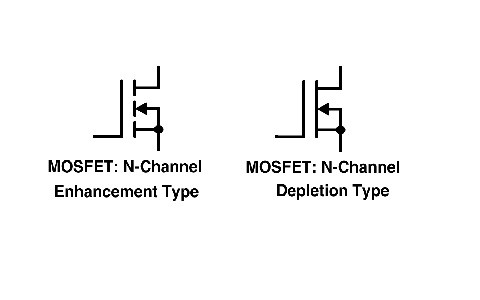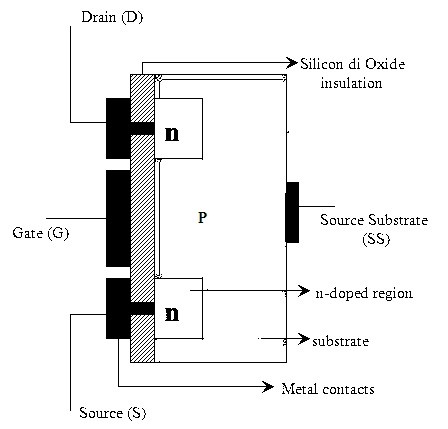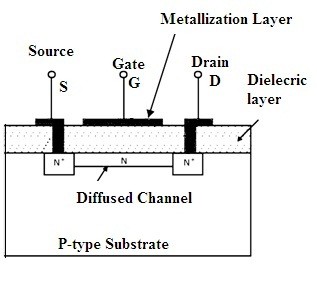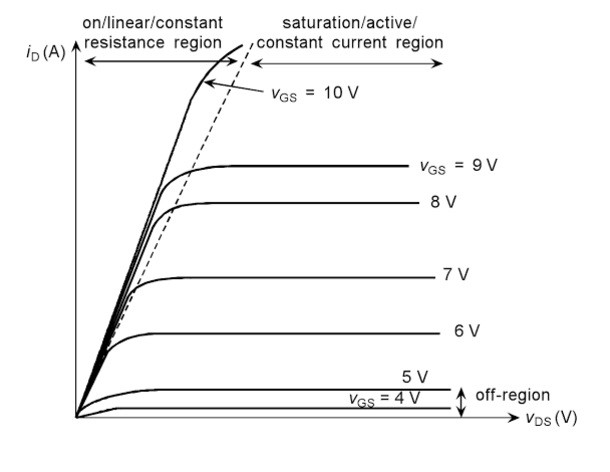N-Channel MOSFET is a type of metal oxide semiconductor field-effect transistor that is categorized under the field-effect transistors (FET). MOSFET transistor operation is based on the capacitor. This type of transistor is also known as an insulated-gate field-effect transistor (IGFET). Sometimes it is also known as a metal-insulator field-effect transistor (MIFET). This type of transistor is further classified as p-type and n-type. These p-types and n-type MOSFETs are further classified as enhancement and depletion-based MOSFETs. This classification is based on the formation of the channel prior to or the operation induced due to the existing channel. These transistors also consist of three terminals which are referred to as the source, drain, and gate. The functionality of the MOSFETs is dependent on these terminals.
What is N-Channel MOSFET?
The MOSFET formed in which the conduction is due to the channel of majority charge carriers called electrons. When this MOSFET is activated as ON this condition results in the maximum amount of the current flow through the device. This type of MOSFET is defined as N-channel MOSFET.

Symbols for N-channel Depletion and Enhancement Types
These n-channel MOSFETs are further classified as
- N-Channel with Enhancement MOSFET and
- N-Channel with Depletion MOSFET
Working
The working of the n-channel MOSFET is based on the majority of the carriers that are electrons. These electrons move in the channel is responsible for the flow of current in the transistor. The p-substrate material is required in the formation of the gate terminals.
(1) N-Channel with Enhancement MOSFET
In n-channel MOSFET the body is formed due to the p-substrate material that is technically referred to as the substrate. The n-type material is required for the formation of the terminals called the source and the drain. Here the p substrate impurities are doped with light concentration whereas the n-type is doped heavily.

N-Channel Enhancement MOSFET
The device body that is formed due to p-type and the terminal source are connected to a common ground. A positive polarity of the voltage is applied to the terminal gate. Because of this positivism, it corresponds to an effect of the capacitor. Hence in the p substrate, the minority carriers that are free electrons get attracted and move toward the terminal gate.
Due to this a layer that is because of uncovered ions is formed below the layer of dielectric where the combinations of the holes with electrons occur. As the positive voltage applied gradually increases and crosses the minimum threshold the electrons which are minority carriers would be able to overcome the recombination with the holes and they form the channel between the two p-type materials.
Further application of the positive voltage value at the drain leads to the flow of current through the transistor. The concentrations of the electrons are dependent on the potential applied. These concentrations of electrons are responsible for the formation of the channel and the application of the voltage at the gate enhances the flow of the current. Hence it is termed as N- channel MOSFET of enhancement type.
Please refer to this link to know more about MOSFET MCQs
(2) N-Channel Depletion MOSFET
The construction is similar to the enhancement MOSFET but the working is different in comparison to it. The space that is present in between the terminals of the drain and the terminal source is composed of the impurities of n-type. A difference in potential applied at the drain and the terminal source leads to the flow of current through the region n.

N-Channel Depletion MOSFET
A voltage value with a negative polarity is applied at the gate. The electrons present in it get repelled and settle down at the dielectric layer. This is the reason due to which the depletion of the charge carriers occurs and results in the reduction of the overall conductance. In this situation after applying the same value of the voltage at the terminal drain still, the current value gets reduced.
By making the variations at the depletion charge carriers the flow of current at the drain can be controlled. This is the reason it is defined as depletion MOSFET. Here the potential value at the drain is positive and the gate has a negative polarity and the terminal source remains at the potential value of zero.
The difference in the values of potential is more at the terminals drain and the gate in comparison to the terminals of the source, and the gate. The depletion width will be evident more at the drain in comparison with the source.
Please refer to this link to know more about P Channel MOSFET.
N-Channel Characteristics
In n-channel enhancement mode, no current flows through the transistor until the voltage at the gate and terminal source exceeds the minimum voltage cut in value. If the voltage at the drain and the terminal source is applied then even there is no evident flow of the current.

I-V Characteristic of N-Channel MOSFET
Don’t Miss:
Please refer to this for How to Select a Transistor.
After the discussion on the basis of n-channel MOSFET can you tell the importance of n-channel enhancement over depletion type?